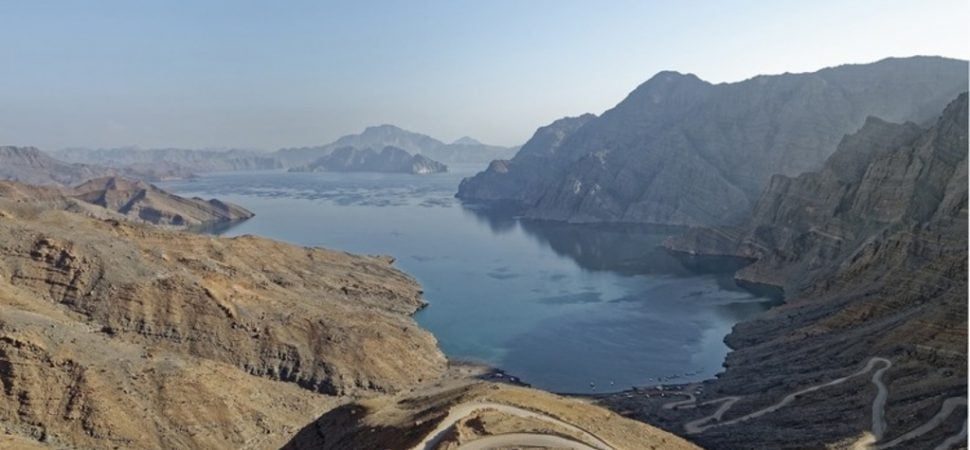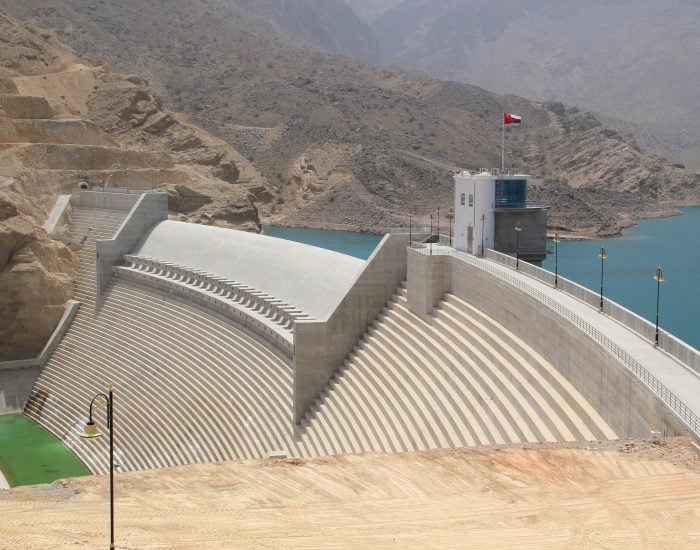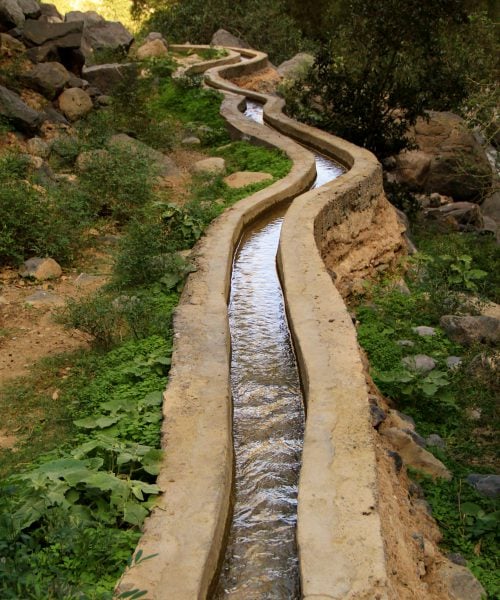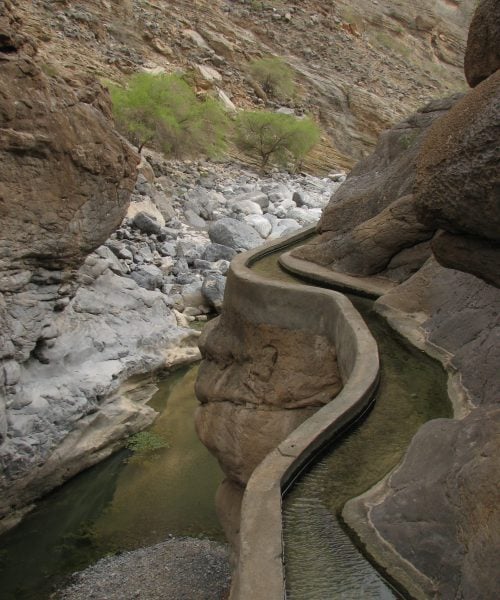
Photo 1: Musan Dam, Oman (Source: Makalu, Pixabay).
Surface water
Surface water, the total volume of which is estimated at 102 million cubic meter (MCM), contributes 6% of the total conventional water and is limited to surface water dam storage. The construction of the Wadi Dayqah dam has shown that dam construction along perennial and quasi-perennial wadis may provide an additional source of water. The dam has the capacity to store up to 100 MCM.
Photo 2 : Wadi Dayqah dam (Source: Black &Veatch, Flickr).
Aflaj Systems
Aflaj (singular: falaj) are channel systems that access groundwater by gravity flow from underground galleries or surface springs on neighbouring mountain slopes. There are more than 3,000 aflaj in Oman, with an average water supply of 552 MCM/yr and losses of 128 MCM/yr due to leakage at the main canals. There are three types of aflaj systems in Oman: ainy, daudi and ghaily, of which ainy and daudi utilize groundwater.[1] Ghaily aflaj intercept the surface water from wadi flow and direct it towards the desired areas. These aflaj are dependent on surface water and they are active only in wet periods. Ainy aflaj intercept the discharge of natural springs and mainly originate from bedding planes, faults and fractures of the carbonate rocks or ophiolites. Daudi aflaj intercept the main groundwater flow by means of channels drilled horizontally along the slope of topographic highs to reach the water table.
Photo 3: A Falaj carrying water through Wadi Qurai in Oman (Source: PParmee, Flickr).
Groundwater
Groundwater occurrence in Oman is largely controlled by the geology and stratigraphy. Groundwater is the main water resource used for domestic, industrial and agricultural purposes. Wells and well fields contribute around 20% of the supplies for these uses and are managed by the Public Authority for Electricity and Water (PAEW).[2]
Figure 1: Estimated water resources.[3]
*Total= Surface water+Groundwater- Overlap
Most of this is from major well fields connected to the main systems. However, other groundwater supplies are typically through single wells or small well fields serving isolated systems, mainly in rural areas. There are 744 wells supplying water to the distribution system, with the greatest numbers in the Dhahirah and Dakhiliyah regions.1 Groundwater is encountered in most areas of the country, with variable storage and quality depending on the geology. In the interior, three main projects for groundwater development have been completed. These are known as Sharqiya Basin, Massarat Basin and Najd Basin.
Sharqiya Basin covers an area of 21,546 km2 and its recharge is estimated at a total of 65 MCM/yr.[4]The total annual demand in the area is estimated at 80 MCM, which means an annual deficit of 10 MCM.
Massarat Basin is located in the Dhahirah region, close to the UAE boarder. The basin covers an area of 12,560 km2, with a maximum depth of 400 m and a widest point of 130 km. Two main well fields have been installed in the lower reaches of the two main wadis: Ain and Abu Karbah. Calculated regional groundwater throughflow is estimated at 17.2 MCM/yr, whereas estimated groundwater storage is 19.5 MCM.
Najd Basin is located in Dhofar and has been hydro-geologically divided into four aquifer units.
However, detailed recharge studies in the basin are still lacking, and the abstraction from Najd may endanger the resources in the region.
| Aquifer Name | Location | Storage (Million m³) |
| Najd | Dhofar | 5,000 |
| Masarrat | Dhahirah | 19,500 |
| Sharqiyah Sands | Sharqiyah | 12,000 |
| Wadi Maawil | South Batinah | 100 |
| West Wusta | Dhofar | 1,000 |
| Wadi Rawnab | Wusta | 100 |
Table 1: Major aquifer systems in Oman.[5]
.
Three main types of natural recharge to the shallow aquifers in Oman can be distinguished:[6]
• Throughflow from precipitation entering the groundwater system in the mountains, which flows down-gradient within the saturated zone to coastal plain aquifers;
• Direct recharge from rainfall over the plains;
• Indirect recharge from wadi stream beds.
Non-conventional Sources
Desalinated Water
Desalination has emerged as a major source of domestic water, and according to the current water strategy, it will meet most of the domestic demand. By the end of 2011, there were 94 desalination plants in Oman, 47 for seawater desalination and 47 for brackish water desalination, producing a total volume of 196 MCM which increased to 214 MCM in 2014 and 268 MCM in 2016.
Oman’s first desalination plant began operation in 1976. The state-owned Oman Power and Water Procurement Company (OPWP), which is the exclusive buyer of power and desalinated water from independent producers, has taken major steps to increase the desalination capacity of independent water projects (IWPs) by 107,300 m3 of water per day (m3/day) in the next six years.
OPWP charges a bulk supply tariff to PAEW, with capacity (fixed) and output (variable) components.The average tariff in 2017 was around 500 baiza, 1.25 USD per cubic metre.
Figure 2: Capacity (m3/day) of desalination plants in Oman.
Desalination operations are integral pieces of Oman’s utility infrastructure, and they provide millions of Omanis with potable water. Water demand in the Main Interconnected System (MIS) is expected to grow between 5% and 7% annually for the next seven years, surging from 281 MCM in 2015 to between 390 MCM and 440 MCM in 2022.[7]
Desalination faces several challenges. These are high cost and energy requirements, non-availability of large storage facilities for meeting emergency requirements, network losses (non-revenue water), which is estimated to be around 30%, and coastal desalination plant closure due to harmful periodic algal blooms.
Figure 3: Desalinated water production (m3/day) from large desalination plants in Oman (2014-2016).
Treated Wastewater
The current daily production of treated wastewater in Muscat is estimated at 100 MCM. The total number of treated wastewater plants is 150, with a total annual volume of 42 MCM. Thus, the total volume of treated wastewater represents only 21.4% of the total desalinated water used for urban purposes. There are 44 wastewater treatment plants under the control of the MRMWR. These plants produce 11.5 MCM/yr. The remaining wastewater treatment plants are managed by the private sector. Among the largest is the Haya Water wastewater plant in Muscat, which in 2012 treated 24.8 MCM. Haya Water is currently undertaking large investment projects to cover the whole Muscat region, and it is expected that the treated wastewater volume will reach 100 MCM by 2030. Currently, most of the treated wastewater is recycled for landscaping and irrigating public gardens in the major cities. Part of the excess treated wastewater is discharged into the sea. In the Dhofar region, around 20,000 m3 of treated wastewater are being injected into the coastal aquifer to combat seawater intrusion. A huge amount of wastewater is produced by oil companies. Overall, Oman uses eight to nine barrels of water for every barrel of heavy oil extracted, and the water produced needs to be treated.
Total Water Availability and per capita Availability
Rainfall provides 15,841 MCM/yr to Oman, with 12,553 MCM/yr lost due to evaporation and initial absorption. Direct recharge from rainfall (2,397 MCM/yr) provides 88% of the inflow, with contributions from wadi recharge (240 MCM/yr), urban recharge (77 MCM/yr) and reservoir recharge (10 MCM/yr). The total amount of direct recharge to Oman is calculated as being 15.1% of rainfall on average; the remainder is lost to evaporation, initial absorption and runoff. According to the FAO,[8] the total internal renewable water resources are estimated at 1,400 MCM/yr, and actual renewable water resources per inhabitant based on the 2005 population is 545 m3/yr.
[1] Available at: http://www.unep.or.jp/ietc/publications/techpublications/techpub-8f/C/Oman1.asp. Accessed on: 4/11/2018.
[2] PAEW, 2014. Annual Report.
[3] http://www.fao.org/nr/water/aquastat/data/wrs/readPdf.html?f=OMN-WRS_eng.pdf
[4] McDonnell, R., 2016. Groundwater governance in the Arab world – Taking stock and addressing the challenges. IWMI Project Report No. 14. USAID AID-263-IO-13-00005.
[5] Al-Khamisi, S., 2011. Optimal Water Resources Management Model for Ash Sharqiyah Region Domestic Water Supply, Oman. PhD dissertation, Heriot-Watt University, Edinburgh, UK.
[6] McDonnell, R., 2016. Groundwater governance in the Arab world – Taking stock and addressing the challenges. IWMI Project Report No. 14. USAID AID-263-IO-13-00005.
[7] OPWP, 2016. OPWP’s 7-Year Statement (2016-2022). Available at www.omanpwp.com/PDF/7YS%202016-2022%20Final%20.pdf.
[8] Available at: http://www.fao.org/nr/water/aquastat/countries_regions/OMN/index.stm. Accessed on 11/4/2018.




